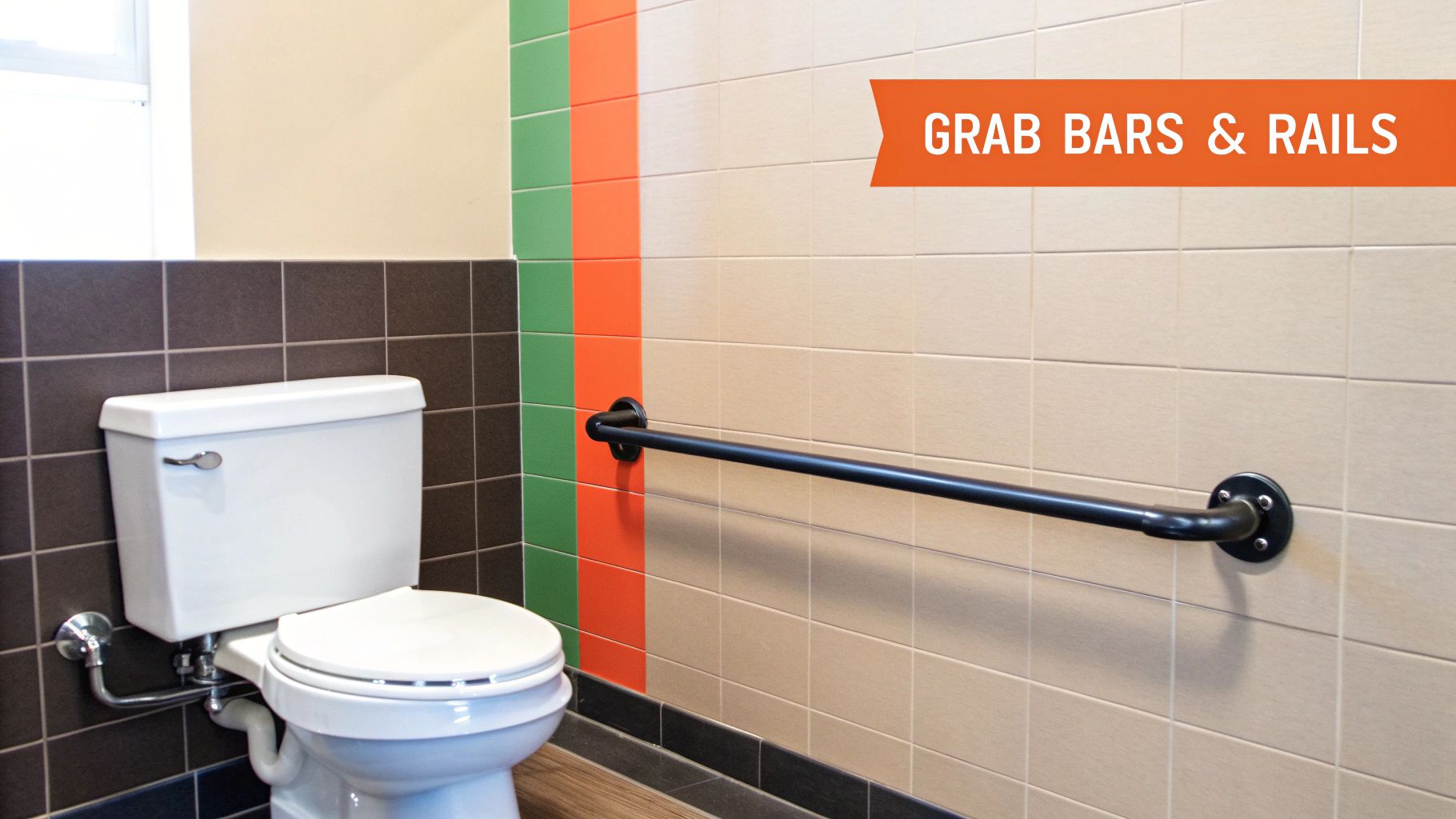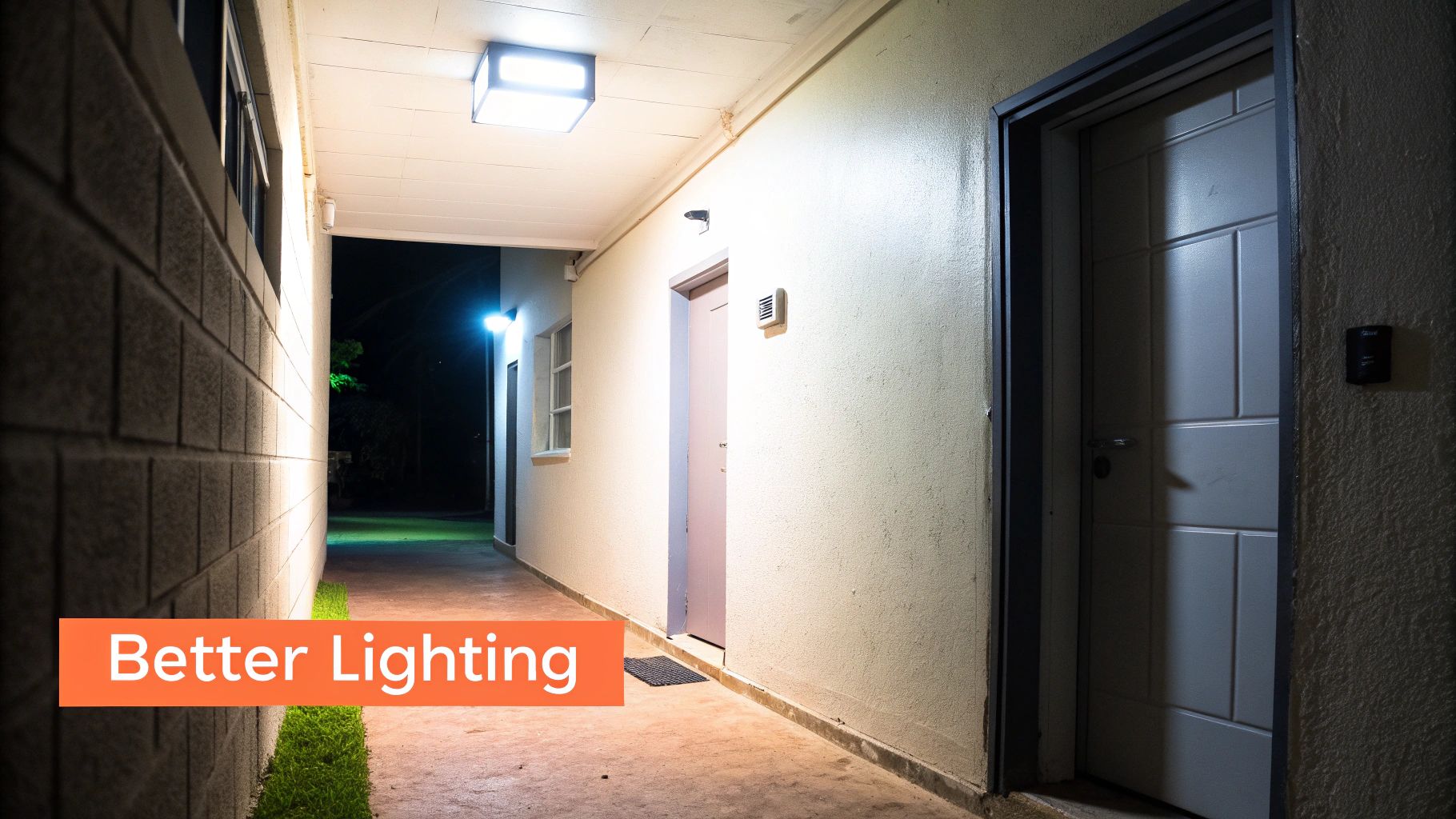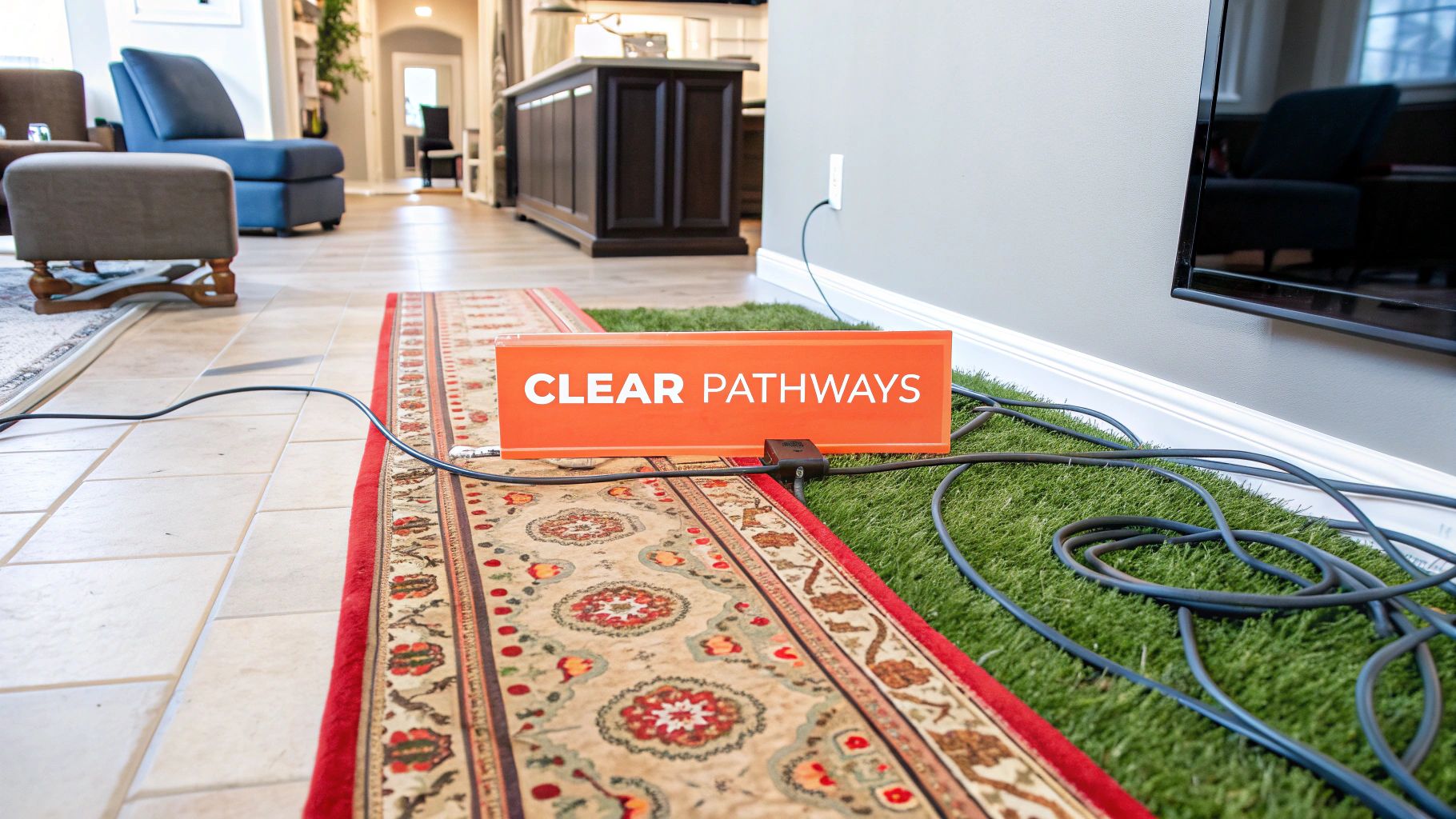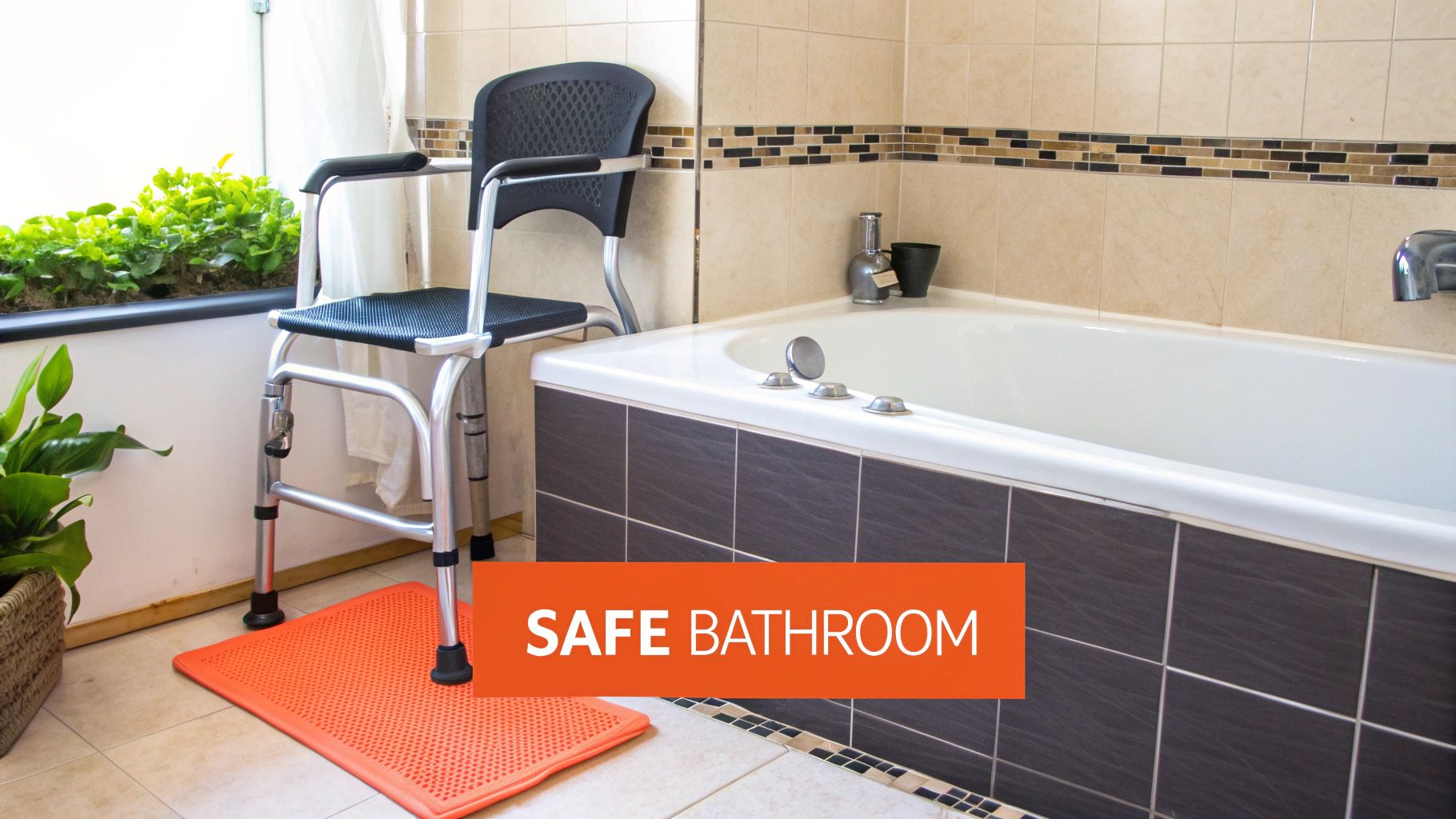-
CALL US:
- (866) 952-3456
As we or our loved ones age, the comfort of home can also present unforeseen risks. Falls, medication errors, and security vulnerabilities are common concerns, but they are not inevitable. A proactive approach to home safety is one of the most empowering steps you can take to support independence, confidence, and well-being for years to come. This guide moves beyond generic advice, offering a curated roundup of critical, room-by-room home safety tips for seniors.
We will explore practical modifications, smart technology, and simple habit changes that make a significant, measurable impact on daily life. This comprehensive listicle provides specific, actionable insights designed to prevent accidents before they happen. You will learn how to properly install grab bars, optimize lighting to prevent falls, and eliminate common tripping hazards often overlooked in familiar spaces.
Furthermore, we will detail the benefits of modern medical alert systems, explain methods for securing medications, and offer crucial strategies for enhancing bathroom safety. We will also cover essential home security measures to provide peace of mind for the entire family. These strategies will help you transform any living space from a potential hazard into a true sanctuary. Let's explore how to make home the safest place it can be.
One of the most effective home safety tips for seniors is the strategic installation of grab bars and handrails. These are not mere accessories; they are essential stability aids that provide a secure point of contact, significantly reducing the risk of falls during routine activities like bathing, using the toilet, or navigating hallways and stairs. Unlike towel racks or soap dishes, grab bars are specifically engineered and anchored to support an adult's full body weight, offering reliable support when it's needed most.

The widespread adoption of these devices in senior living facilities and hospitals, such as those using Moen Home Care or Delta Faucet HealthCraft products, underscores their proven effectiveness. By providing sturdy support, they empower seniors to maintain balance and move with greater confidence and independence throughout their homes.
Proper installation is crucial for safety and effectiveness. Incorrectly mounted bars can fail under pressure, creating a severe hazard.
Professional Insight: For a truly customized and effective setup, consider hiring an occupational therapist. They can perform a home safety assessment and recommend the precise placement and type of grab bars based on an individual’s specific mobility challenges and daily routines.
By integrating these fixtures, you are making a proactive investment in long-term safety and independence. For a deeper look into this and other modifications, explore these comprehensive home modifications for seniors to create a safer living environment.
Enhancing illumination is one of the most critical yet often overlooked home safety tips for seniors. As vision naturally declines with age, brighter and more strategically placed lighting becomes essential for preventing trips, slips, and falls. Proper lighting helps seniors better identify potential hazards like rugs, steps, or misplaced objects, ensuring they can navigate their living space safely and confidently, especially at night.

The importance of this is recognized by organizations like the CDC and the AARP HomeFit Program, which consistently advocate for lighting improvements. Automated and brighter solutions, such as Mr. Beams motion-sensor lights in hallways or Philips Hue smart systems, are increasingly used in senior living communities to provide light exactly when and where it's needed without fumbling for a switch. These upgrades make a significant difference in reducing accident risks in key areas.
Effective lighting is about more than just brighter bulbs; it’s about creating a uniformly lit environment that eliminates dangerous shadows and dark spots.
Professional Insight: To combat shadowy corners, use multiple light sources within a single room, such as a combination of overhead fixtures, floor lamps, and table lamps. Beyond artificial lights, consider these additional tips to brighten dark rooms to maximize natural light and further reduce shadows and improve overall visibility.
By systematically upgrading your home’s lighting, you can create a safer, more comfortable, and visually accessible environment that supports independence and well-being.
One of the most immediate and impactful home safety tips for seniors is the systematic removal of tripping hazards. Common household items like loose area rugs, stray electrical cords, clutter, and even small changes in floor height can pose a significant fall risk. Clearing these obstacles creates unobstructed pathways, allowing for safer and more confident movement throughout the home, which is a fundamental aspect of aging in place.

This proactive approach is championed by organizations like the National Institute on Aging and the AARP Foundation through their HomeFit programs, which emphasize creating a living environment that is as safe and accessible as possible. Understanding the broader impact on falls and fragility fractures is crucial for implementing these effective preventative measures, as a simple fall can have severe consequences for an older adult’s health and independence.
Regularly scanning the home for potential dangers is key to maintaining a safe environment. Focus on high-traffic areas like hallways, living rooms, and bedrooms.
Professional Insight: Schedule a monthly "safety walk-through" of the home. This simple habit helps you spot new hazards, like a curled rug edge or a new extension cord, before they become a problem. Viewing the home with a critical eye for safety makes prevention an active, ongoing process.
By diligently clearing pathways, you significantly reduce the odds of a preventable fall. For a more structured approach, you can use a comprehensive home safety checklist for seniors to ensure all potential risks are addressed.
Implementing a medical alert system is one of the most vital home safety tips for seniors, providing an immediate lifeline in the event of a fall, sudden illness, or other emergency. These personal emergency response systems (PERS) offer peace of mind to both seniors and their loved ones. They typically consist of a wearable device, like a pendant or wristband with a help button, that wirelessly connects to a base unit, instantly alerting a 24/7 monitoring center staffed with trained professionals.
The proven effectiveness of these systems is demonstrated by leading providers like Life Alert, famous for its "I've fallen and I can't get up!" campaign, and Medical Guardian, which serves over 300,000 customers. By offering a direct link to emergency services, these devices empower seniors to live independently, knowing that help is just the push of a button away, even when they are alone.
To maximize the effectiveness of a medical alert system, proper setup and regular maintenance are essential. The right choice depends on the individual's lifestyle and specific health needs.
Professional Insight: When evaluating systems, look for features that match your specific needs, such as automatic fall detection, medication reminders, or activity monitoring. Beyond traditional medical alert devices, understanding the options for the best AED for home use can be a critical step in preparing for sudden cardiac emergencies.
By choosing and maintaining the right system, you create a powerful safety net that supports independence and provides invaluable reassurance for everyone involved.
Implementing safe storage and management for medications is a critical, yet often overlooked, home safety tip for seniors. Proper medication management goes beyond simply taking pills on time; it involves a systematic approach to prevent dangerous mix-ups, accidental overdoses, and adverse drug interactions. Forgetting a dose or taking a wrong one can have serious health consequences, making a clear system essential for safety and well-being.
The success of structured medication protocols is evident in professional healthcare settings, from hospital pharmacy medication reconciliation programs to senior living facilities. Innovative services like PillPack by Amazon Pharmacy, which pre-sorts medications into daily packets, and CVS Health's medication synchronization programs bring this level of organization directly into the home, simplifying complex regimens and enhancing safety.
A well-organized system is the foundation of medication safety. Adhering to best practices ensures medications are taken correctly and remain effective.
Professional Insight: Schedule a "brown bag review" with a pharmacist at least once a year. This involves bringing all current medications, including supplements and over-the-counter products, for a comprehensive review to identify potential interactions, confirm proper usage, and eliminate unnecessary prescriptions.
By establishing a robust medication management routine, you create a vital safety net that supports health and independence. You can find more information on this and other important topics in these household safety tips.
The bathroom presents one of the highest risks for seniors, with a combination of wet surfaces, hard fixtures, and frequent transfers making it a common site for accidents. Enhancing bathroom safety involves a series of proactive modifications to minimize these dangers, addressing everything from slip hazards to accessibility challenges. These changes are crucial home safety tips for seniors, as they directly mitigate the environmental factors contributing to the majority of falls.

Leading companies like Kohler Co. and Safe Step Walk-In Tubs specialize in bathroom conversions designed for aging in place, demonstrating a market-wide recognition of this critical need. By implementing thoughtful changes such as walk-in showers or strategically placed aids, you can transform a high-risk area into a secure and functional space that supports independence and prevents serious injuries.
A comprehensive approach to bathroom safety addresses multiple potential hazards simultaneously. Focus on creating a stable, accessible, and slip-resistant environment.
Professional Insight: Before purchasing equipment, check for potential coverage. Some durable medical equipment for bathroom safety, like toilet safety frames or shower chairs, may be covered by Medicare Part B if prescribed by a doctor as medically necessary. This can make essential modifications more affordable.
By layering these modifications, you create a multi-faceted safety system that significantly reduces the risk of falls and enhances daily confidence. For a detailed guide on available modifications, exploring resources from the National Association of Home Builders (NAHB) can provide valuable, industry-vetted insights.
A crucial aspect of home safety for seniors involves implementing comprehensive security measures to protect against external threats like break-ins, scams, and unauthorized entry. Modern security solutions and sound practices provide peace of mind for both seniors and their families. These systems are not just about alarms; they offer visibility, communication, and control, addressing potential vulnerabilities that seniors may face.
The increasing popularity of user-friendly systems like the Ring Video Doorbell or SimpliSafe's wireless setups highlights a shift towards accessible technology. These tools empower seniors by allowing them to see who is at their door without opening it, and they enable family members to monitor the home remotely. Major providers like ADT now offer packages with senior-friendly features, such as wearable emergency alert buttons that integrate directly with their monitoring services.
A layered security approach combining technology and smart habits is most effective. Simple adjustments can significantly deter potential intruders and prevent scams.
Professional Insight: Encourage seniors to establish a "buddy system" with a trusted neighbor. They can agree to check in on each other daily and watch each other's homes when one is away. This simple, no-cost social connection adds an invaluable layer of security and community support.
By integrating these measures, you are building a robust defense against common risks. For a more exhaustive list of safety precautions, use this detailed home safety checklist to identify and address potential vulnerabilities in every room.
| Item | Implementation Complexity 🔄 | Resource Requirements ⚡ | Expected Outcomes 📊 | Ideal Use Cases | Key Advantages ⭐ / 💡 |
|---|---|---|---|---|---|
| Install Grab Bars and Handrails | Moderate – requires proper mounting and possible professional help | Low to Moderate – materials and installation tools | High – significantly reduces fall risk in key areas | Bathrooms, stairways, hallways needing stability support | ⭐ Reduces falls, increases independence; 💡 Proper stud mounting essential |
| Improve Home Lighting | Moderate – may involve electrical work | Moderate to High – lighting fixtures, bulbs, sensors | High – enhances visibility, reduces trips by ~39% | Whole home, especially dark or hazardous areas | ⚡ Energy-efficient LEDs; ⭐ Motion sensors for hands-free use |
| Remove Tripping Hazards | Low to Moderate – decluttering and minor repairs | Low to Moderate – organizational tools, minor repairs | High – immediate fall risk reduction with low cost | Entire home, especially high-traffic zones | ⭐ Cost-effective; 💡 Monthly safety checks recommended |
| Install Medical Alert Systems | Low – mainly device setup, some tech knowledge | Moderate – device purchase plus monthly fees | High – faster emergency response; peace of mind | Seniors with high fall/medical emergency risk | ⭐ 24/7 monitoring; ⚡ Mobile and fall detection options |
| Secure Medications Properly | Low – organizational and storage setup | Low to Moderate – organizers, storage boxes, apps | High – prevents medication errors and overdoses | Homes with multiple or complex medications | ⭐ Safety in medication use; 💡 Regular reviews with pharmacists |
| Enhance Bathroom Safety | Moderate to High – may involve renovations | Moderate to High – equipment and possible remodeling | Very High – significantly reduces highest-risk room falls | Bathrooms with seniors or mobility issues | ⭐ Increases accessibility; 💡 Non-slip surfaces critical |
| Implement Home Security Measures | Moderate to High – installation and setup | Moderate to High – security devices plus possible monitoring fees | High – protects against intrusions and scams | Homes needing security and remote family monitoring | ⭐ Integrated monitoring; ⚡ Remote access and alerts |
Creating a truly safe and supportive home environment for a senior is not a one-time project; it is an ongoing commitment to well-being and independence. As we've explored, the most effective strategies often involve a blend of simple habit changes and more significant home modifications. By addressing key areas room by room, you are not just preventing accidents, you are actively building a foundation for a more confident and autonomous future.
This comprehensive guide has provided a blueprint, covering seven critical pillars of senior home safety. We began with the structural supports, like the strategic installation of grab bars and handrails in high-traffic areas and bathrooms, which provide crucial stability. We then illuminated the importance of enhanced lighting, from bright ambient fixtures to motion-activated night lights, to ensure every corner of the home is visible and safe to navigate at all hours.
Many of the most impactful home safety tips for seniors involve proactive prevention. Systematically removing tripping hazards is a perfect example. Securing rugs, clearing pathways of clutter, and organizing electrical cords are small, actionable steps that yield enormous benefits by drastically reducing the risk of falls, which are a leading cause of injury.
Beyond physical modifications, we highlighted the peace of mind that comes from modern technology. Medical alert systems serve as a vital lifeline, offering immediate access to help with the simple push of a button. Similarly, implementing robust home security measures like smart doorbells and alarms provides a powerful deterrent against intruders, adding an essential layer of emotional and physical security for seniors living alone.
Finally, we delved into specific high-risk zones and daily routines. Enhancing bathroom safety with non-slip mats, shower chairs, and raised toilet seats transforms one of the most hazardous rooms into a secure space. Equally important is the diligent management and proper security of medications, using pill organizers and locked storage to prevent accidental mix-ups or misuse.
Each of these seven strategies, from the simplest decluttering effort to the installation of new safety equipment, is a building block. They work together to create a holistic ecosystem of safety that supports independence, respects dignity, and provides invaluable peace of mind for both seniors and their loved ones. The ultimate goal is to adapt the living space to meet evolving needs, fostering an environment where seniors can continue to thrive, engage, and live life on their own terms, safely and securely.
Don't let the challenge of installing new safety equipment or furniture become a barrier to a safer home. For professional, reliable, and secure installation of grab bars, new lighting fixtures, or organizational furniture, trust the experts at Assembly Smart. Visit Assembly Smart to ensure every modification is done right, giving you and your loved ones complete confidence.